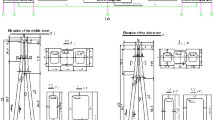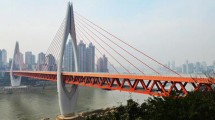Abstract
The damping characterization is important in making accurate predictions of the seismic response of the hybrid structures dominated by different damping mechanisms. Different damping characteristics arise from the construction of the tower with different materials: steel for the upper part; reinforced concrete for the lower main part and interaction with supporting soil. The process of modeling damping matrices and experimental verification is challenging because damping cannot be determined via static tests as mass and stiffness can be. The assumption of classical damping is not appropriate if the system to be analyzed consists of two or more parts with significantly different levels of damping. The dynamic response of structures is critically determined by the damping mechanisms, and its value is very important for the design and analysis of vibrating structures. An analytical approach that is capable of evaluating the equivalent modal damping ratio from structural components is desirable for improving seismic design. Two approaches are considered to define and investigate dynamic characteristics of a composite tower of cable-stayed bridges: The first approach makes use of a simplified approximation of two lumped masses to investigate the structure irregularity effects including damping of different material, mass ratio, frequency ratio on dynamic characteristics and modal damping. The second approach employs a detailed numerical step-by-step integration procedure.














Similar content being viewed by others
References
Johnson C D and Kienhholz D A 1982 Finite element prediction of damping in structures. Am. Inst. Aeronaut. Astronaut. J. 20 (9): 1284–1290
Kawashima K, Unjoh S and Tunomoto M 1993 Estimation of damping ratio of cable-stayed bridges for seismic design . J. Struct. Eng. 119 (4): 1015–1031, doi:10.1061/(ASCE)0733--9445(1993)119:4(1015)
Huang B C, Leung A Y T, Lam K M and Cheung Y K 1995 Analytical determination of equivalent modal damping ratios of a composite tower in wind-induced vibrations. Comput. Struct. 59 (2): 311–316, doi:10.1016/0045-7949(95)00258-8
Casciati F, Cimellaro G P and Domaneschi M 2008 Seismic reliability of a cable-stayed bridge retrofitted with hysteretic devices. Comput. Struct. 86 (17–18): 1769–1781, doi:10.1016/j.compstruc.2008.01.012
Abdel Raheem S E and Hayashikawa T 2007 Damping characteristics in soil-foundation-superstructure interaction model of cable-stayed bridges tower. J. Construct. Steel Japanese Soc. Steel Construct. 15: 261–268
Abdel Raheem S E and Hayashikawa T 2008 Vibration and damping characteristics of cable-stayed bridges tower. International Association for Bridge and Structural Engineering – IABSE Conference, Information and Communication Technology (ICT) for Bridges, Buildings and Construction Practice, Helsinki, Finland, June 4–6, 2008, Paper ID. F15
Lee S, Feng M Q, Kwon S -J and Hong S -H 2011 Equivalent modal damping of short-span bridges subjected to strong motion. J. Bridge Eng. 16 (2): 316–323, doi:10.1061/(ASCE)BE.1943-5592.0000149
Cimellaro G P, Soong T T and Reinhorn A M 2009 Integrated design of controlled linear structural systems. J. Struct. Eng. ASCE 135 (7): 853–862, doi:10.1061/(ASCE)ST.1943-541X.0000032
Soong T T and Cimellaro G P 2009 Future directions on structural control. J. Struct. Control Health Monitoring 16 (1): 7–16, doi:10.1002/stc.291
Abdel Raheem S E, Hayashikawa T and Dorka U 2009 Seismic performance of cable-stayed bridge towers: nonlinear dynamic analysis, structural control and seismic design. VDM Verlag, ISBN: 978-3639202236
Prater G and Singh R 1990 Eigenproblem formulation, solution and interpretation for non-proportionally damped continuous beams. J. Sound Vibr. 143 (1): 125–42, doi:10.1016/0022-460X(90)90572-H
Prells U and Friswell M I 2000 A measure of non-proportional damping. Mech. Syst. Signal Process. 14 (2): 125–137, doi:10.1006/mssp.1999.1280
Angeles J and Ostrovskaya S 2002 The proportional damping matrix of arbitrarily damped linear mechanical systems. J. Appl. Mech. 69: 649–656, doi:10.1115/1.1483832
Du Y, Li H and Spencer B F 2002 Effect of non-proportional damping on seismic isolation. J. Struct. Control 9: 205–236, doi:10.1002/stc.13
Adhikari A 2004 Optimal complex modes and an index of damping non-proportionality. Mech. Syst. Signal Process. 18: 1–27, doi:10.1016/S0888-3270(03)00048-7
Xu J, DeGrassi G and Chokshi N 2004a A NRC-BNL benchmark evaluation of seismic analysis methods for non-classically damped coupled systems. Nucl. Eng. Des. 228: 345–366, doi:10.1016/j.nucengdes.2003.06.019
Xu J, DeGrassi G and Chokshi N 2004b Insights Gleaned from NRC-BNL benchmark evaluation of seismic analysis methods for non-classically damped coupled systems. J. Pressure Vessel Technol. 126: 75–84, doi:10.1115/1.1638388
Khanlari K and Ghafory-Ashtiany M 2005 New approaches for non-classically damped system Eigen analysis. Earthq. Eng. Struct. Eng. 34: 1073–1087, doi:10.1002/eqe.467
Qu Z -Q, Selvam R P and Jung Y 2003 Model condensation for non-classically damped systems-part ii: Iterative schemes for dynamic condensation. Mech. Syst. Signal Process. 17 (5): 1017–1032, doi:10.1006/mssp.2002.1527
Bert C W 1973 Material damping: an introductory review of mathematical models, measure and experimental techniques. J. Sound Vibr. 29 (2): 129–153
Bread C F 1979 Damping in structural joints. J. Shock Vibr. Digest 11 (9): 35–41
Chang S -Y 2013 Nonlinear performance of classical damping. Earthq. Eng. Eng. Vibr. 12: 279–296
Chopra A K 1995 Dynamic of structures – theory and application to earthquake engineering. Prentice-Hall, Englewood Cliffs, NJ
Ding N H, Lin L X and Chen J D 2011 Seismic response analysis of double chains suspension bridge considering non-classical damping. Adv. Mater. Res., 255–260,: 826–830, doi:10.4028/AMR.255-260.826
Raggett J D 1975 Estimation of damping of real structures. J. Struct. Div. ASCE 101 (ST9): 1823–1835
Lee S -H, Min K -W, Hwang J -S and Kim J 2004 Evaluation of equivalent damping ratio of a structure with added dampers . Eng. Struct. 26: 335–346, doi:10.1016/j.engstruct.2003.09.014 10.1016/j.engstruct.2003.09.014
Papageorgiou A V and Gantes C J 2010 Equivalent modal damping ratios for concrete/steel mixed structures. Comput. Struct. 88 (19–20): 1124–1136, doi:10.1016/j.compstruc.2010.06.014
Papageorgiou A V and Gantes C J 2011 Equivalent uniform damping ratios for linear irregularly damped concrete/steel mixed structures. Soil Dynamic Earthq. Eng. 31 (3): 418–430, doi:10.1016/j.soildyn.2010.09.010
Villaverde R 2008 A complex modal superposition method for the seismic analysis of structures with supplemental dampers. 14th world conference on earthquake engineering, 14WCEE, Beijing, China
Warburton G B and Soni S R 1977 Errors in response calculations for non-classically damped structures. Earthq. Eng. Struct. Dyn. 5: 365–376, doi:10.1002/eqe.4290050404
Qin Q and Lou L 2000 Effects of non proportional damping on the seismic responses of suspension bridges. 12th world conference of earthquake engineering, Auckland, New Zealand, 30 January - 4 February 2000, paper No. 0529
Japan Road Association 1996 Reference for highway bridge design, Specification for highway bridges-part IV substructures. Chapter 7–9
Japan Road Association 2002 Specification for highway bridges-Part V Seismic design. Maruzen, Tokyo, Japan
Claret A M and Venancio-Filho F 1991 A modal superposition method pseudo-force method for dynamic analysis of structural systems with non-proportional damping. Earthq. Eng. Struct. Eng. 20: 303–315, doi:10.1002/eqe.4290200402
Falsone G and Muscolino G 2004 “New real-value modal combination rules for non-classically damped structures. Earthq. Eng. Struct. Eng. 33: 1187–1209, doi:10.1002/eqe.394 10.1002/eqe.394
Veletsos A S and Ventura C E 1986 Model analysis of non-classically damped linear systems. Earthq. Eng. Struct. Dyn. 14: 217–243, doi:10.1002/eqe.4290140205
Abdel Raheem S E, Hayashikawa T and Hashimoto I 2003 Effects of soil-foundation-superstructure interaction on seismic response of cable-stayed bridges tower with spread footing foundation. J. Struct. Eng. – JSCE 49A: 475–486
Park D and Hashash Y M A 2004 Soil damping formulation in nonlinear time domain site response analysis. J. Earthq. Eng. 8 (2): 249–274, doi:10.1080/13632460409350489
Hayashikawa T, Abdel Raheem S E and Hashimoto I 2004 Nonlinear seismic response of soil-foundation-structure interaction model of cable-stayed bridges tower. 13th World Conference on Earthquake Engineering, Vancouver, Canada, 1–6 August, Paper No. 3045
Abdel Raheem S E and Hayashikawa T 2013a Energy dissipation system for earthquake protection of cable-stayed bridge towers. Int. Earthquakes Structures, Techno-Press publishers 5 (2): 657–678, doi:10.12989/eas.2013.5.6.657
Abdel Raheem S E and Hayashikawa T 2013b Soil-structure interaction modeling effects on seismic response of a cable-stayed bridge tower. Int. J. Adv. Struct. Eng. 5 (8): 1–17, doi:10.1186/2008-6695-5-8
Petrini L, Maggi C, Priestley M J N and Calvi G M 2008 Experimental verification of viscous damping modelling for inelastic time history analyses. J. Earthq. Eng. 12 (SP1): 125–145, doi:10.1080/13632460801925822
Author information
Authors and Affiliations
Corresponding author
Rights and permissions
About this article
Cite this article
ABDEL RAHEEM, S.E. Exploring damping characteristics of composite tower of cable-stayed bridges. Sādhanā 41, 345–358 (2016). https://doi.org/10.1007/s12046-016-0467-x
Received:
Accepted:
Published:
Issue Date:
DOI: https://doi.org/10.1007/s12046-016-0467-x




